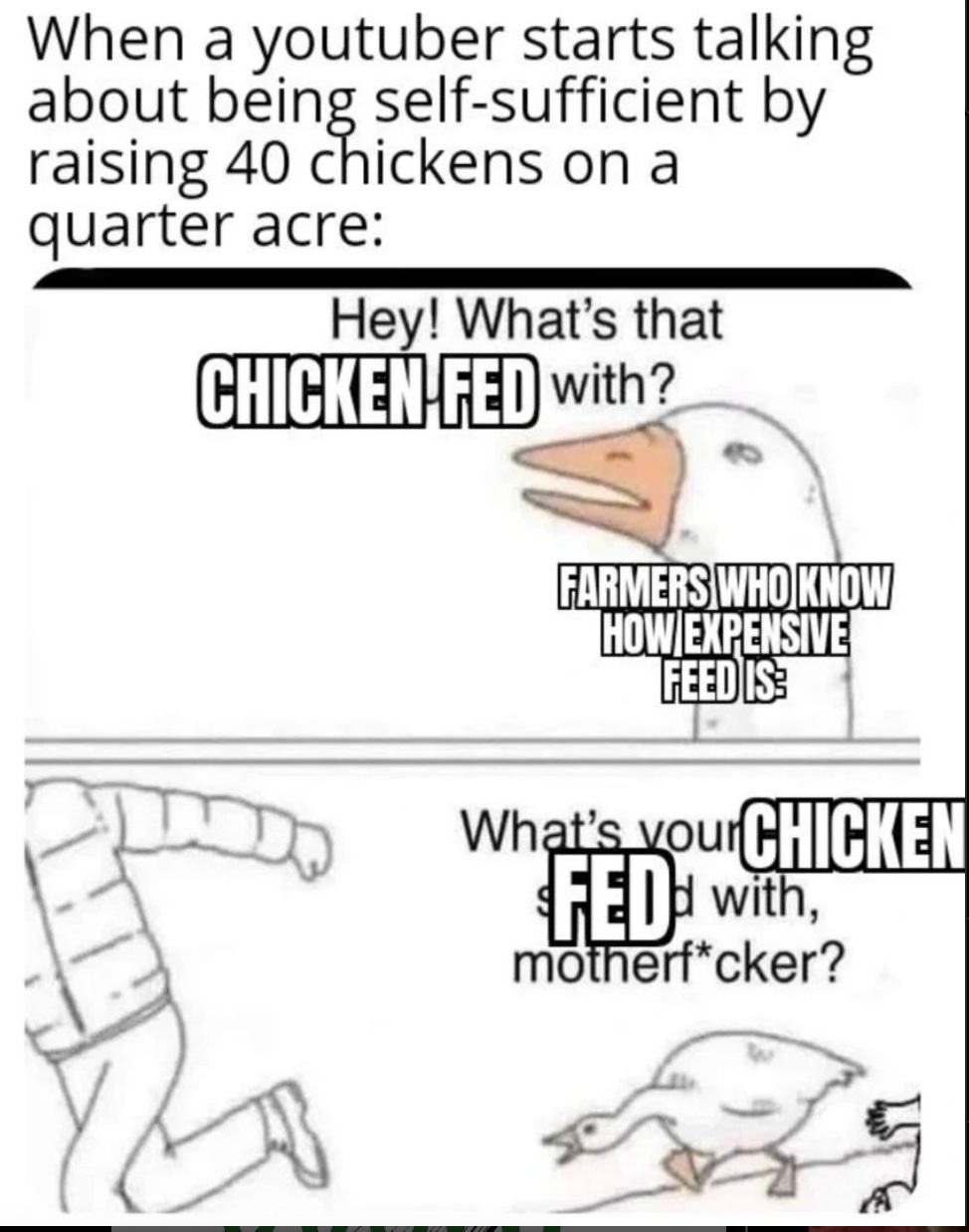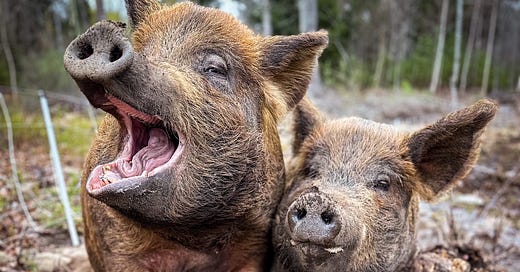When my husband and I began homesteading in earnest in 2017, we were firm believers in the idea of self sufficiency. It was the driving force behind my urge to go rural: I wanted to be attached to no system outside of my own control.
It became obvious quickly that “self sufficiency” was not a reasonable goal. Any homesteader will explain how important community is, and most successful back-to-the-landers have cultivated community in their area (or found ways to entice volunteers and interns). But beyond the necessity of assistance with equipment or harvests, I came to realize that self sufficiency was particularly difficult to achieve with livestock.
I embraced the idea of “permaculture pets”, thinking that while we did not eat our animals they could provide us with necessary services. Their work on the land would save us money and time, and we would still be able to use their milk and eggs. And this system can work. Animals can help manage land, living in harmony on your farm and helping your achieve tasks in a more environmentally and pocket-friendly manner.
Before I begin to take this idea apart a little bit, I want to underline that our animals have been extremely helpful in many ways. Our pigs are the best organic mini-excavators out there. The goats are hard to manage but insatiable in their appetites for weeds. The sheep, as advertised, nibble grass but don’t eat trees. The system, on its face, works perfectly. My argument is with how its presented by permaculturists — myself, until now, included — as all the pros and none of the cons. It seems like it’s considered inappropriate to mention the costs of raising animals this way, or to imply that it might be difficult, so no one ever does. I’m about to.
You have to have the time and money to set things up properly so that your animals can do their jobs effectively. I’m going to go out on a limb and say that the majority of successful or “model” homesteaders have some kind of disposable income going towards the project. And there’s nothing wrong with that. What there is an issue with is promoting the lifestyle as achievable for anyone with a bit of land and a goat, when in fact you’ll be spending thousands on infrastructure and often not have time for a day job anymore.
My first example is fencing. When I watched ‘Biggest Little Farm’, a charming movie about a regenerative farm in California, my first thought was how many thousands of dollars were spent on fencing. Movable net fencing runs a few hundred dollars for a few hundred feet and requires a moveable solar charger which is also a few hundred dollars (and will need replacement parts within a few years). That’s not entirely cost prohibitive, but it is significant. Then, you have to consider that most animals will go through an electric fence if the charge isn’t on for a few days. Sometimes they’ll get caught up in the fencing and die, sometimes they’ll just break out and eat your garden. Either way, electric fencing requires extra attention — personally, I do not leave my animals in electric netting if I am not home, and I do this from experience not out of random paranoia.
So you consider permanent fencing. Permanent fencing requires full sized posts, hog panels or no climb fencing will run several hundred dollars — our garden fence, which covers a quarter of an acre and consists of hog panels and t-posts, cost us over a thousand dollars. That’s real money. And if you’re doing a permaculture model you’re going to want to set that up three or four times over for effective rotational grazing.

Now what if your animal does get stuck in electric fencing, or gets injured in some other way? Vet visits aren’t something you can be self sufficient about. Yes, there are routine vet tasks you can do yourself, but if you want to properly care for your animals you need a relationship with a large animal vet.
The thing with the vet is that you can go a year without using them at all, or having one routine $200-500 visit. But then you can have a calamity, and you’ll quickly be set back thousands of dollars. I have to admit that whenever a fellow “farm influencer” (ick) posts about an emergency vet visit for one of their animals, one of the things I wonder about is how much it cost. As with any pet, you have to feel confident that if the animal needs it, you can pay for a large vet bill — otherwise, it’s not responsible to bring that animal home.
The aspect of livestock as permaculture that I think is most deceptive is feed. Many permaculturists hail from more temperate climates than mine. And I have no doubt they can get through a mild winter of a few snowstorms and some icing using a minimal amount of hay and supplemental grain. But around here there is no grass or forage from November to April, and for three or four of those months everything is coated in snow (and then ice, and then snow, and then ice). Foraging is impossible in winter here, even if my animals were willing to make the trek outside to try it.
With thirteen goats, four sheep, and two pigs (who only use hay as bedding) we go through 500 bales of hay in a winter and barely make it to the next spring. We don’t feed supplemental grain unless someone is pregnant or nursing, but we do add timothy and alfalfa pellets, sunflower seeds, and of course minerals to their diets. The pigs eat grain to maintain a balanced diet — table scraps alone, even if plentiful, may not meet their nutritional needs. Even in summer, with plenty of forage and table scraps, the pigs eat a few bags of grain in a month, which adds up.
Hay in our area is $9-13 for small square bales at the moment. In a year of plentiful hay harvests (a drier summer with ideal growing conditions), you can get quality feed hay for $6-7/bale. But by winter this year, a very poor year for hay harvest, bales will likely push $20 from the feed store.
My argument here isn’t that animals aren’t effective at land management - they are incredibly effective, especially the pigs. But what we’re sold by the permaculture model is the idea that you can arrive on raw land, set up the right animals for the landscape, and wipe your hands of various costs. In fact you’ll need to fence and house those animals properly, supplement their feed even in ideal foraging conditions, rotate their pastures, and be prepared to spend your savings on a single vet bill.
It’s a matter of balance. Using animals for land management you can feel good about your impact on the environment. You will still save money compared to the purchase of a big piece of equipment or bringing in a land crew. Pigs or goats are ideal for an area that just needs steady clearing over the course of a year or years. And your heart will be oh so full. But don’t kid yourself. It is not that you won’t make it rich farming (most of us don’t get into farming thinking that). It is that you will, most likely, go broke farming.
Of course, this does not take into consideration other ways of saving money or making money from your livestock, such as raising animals for meat or selling milk products. These avenues have associated costs as well (transport, butchering, proper milking equipment), but they also have actual profits. Perhaps there will be more on the promises and pitfalls of that aspect of animal husbandry in a future post.




Appreciate your honest and informative take on this. Excellent writing, as always.